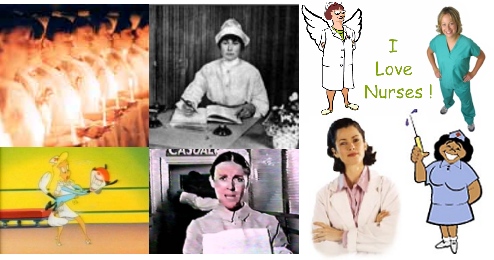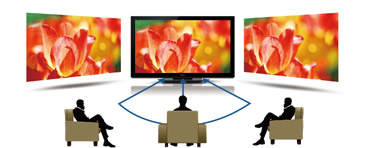Learning Activity 5:
The Impact and Influence of Images
and Roles of Nursing
"Some change their ways when they see the light, others when they feel the heat." - Caroline Schoeder
"There are four ways and only four ways, in which we have contact with the world. We are evaluated and classified by these four contacts: What we do, how we look, what we say and how we say it." - Dale Carnegie
"We must always change, renew, rejuvenate ourselves; otherwise we harden." - Johann Wolfgang Von Goethe
Overview
 The word nursing is derived from the Latin word "nutrire" which means "to nourish." From its earliest beginnings, the nursing profession has evolved in response to human need. There have been many images of nurses purported in the media, in movies and books, and in the news. Common images include: "ministering angel," "physician's handmaiden," "oppressive battle ax a la Nurse Ratched," and sexually related stereotypes ranging from rigid prude to sex kitten. Even though these multiple misconcieved images abound, nurses continue to be quite invisible in the media, compared to other cultural groups.
The word nursing is derived from the Latin word "nutrire" which means "to nourish." From its earliest beginnings, the nursing profession has evolved in response to human need. There have been many images of nurses purported in the media, in movies and books, and in the news. Common images include: "ministering angel," "physician's handmaiden," "oppressive battle ax a la Nurse Ratched," and sexually related stereotypes ranging from rigid prude to sex kitten. Even though these multiple misconcieved images abound, nurses continue to be quite invisible in the media, compared to other cultural groups.
"The 1997 Woodhull Study on Nursing and the Media, conducted by Sigma Theta Tau International, found that nurses were severely under-represented in print media, including in comprehensive coverage of health care. Of 1,153 health care stories in 16 major newspapers, only 11 carried references to nurses, the study found" (Sussman, 2000, p. 1). Nurses are in the background, seen only by the people who have first hand experiences with them - the patients they provide care for. Operating in the media shadow, nurses function as a very real but transparent infrastructure that keeps the health care system from literally falling apart. Rarely do people hear about their fine intellects, their on-the-spot critical, "life or death" thinking, or their heroic efforts to provide accountable, complex, quality health interventions in a time of chaos and crisis. y from close community and family networks. The current wave of health care reform has initiated a focus on primary health care as the foundation of the twenty-first century Canadian health care system.

Around the world, from the Americas to India, nurses have struggled with a poor image in the general social context. Australian nurses have shared in this misconceived identity: "The public image of Australian nursing has been subject to a plethora of influencing factors since health-care services were first established in this country over two centuries ago, Since its colonial origins, when considered an occupation suitable only for the socially outcast, nursing has evolved through decades of changes and reform. From a position of significant oppression and medical subservience, generations of Australian nurses have fought for public recognition in terms of identity, respect and role acknowledgement" (Bloomfield, 1999, p. 1).
Foskett and Hemsley-Brown found that young people held vague and fragmented views of what nurses were and did in their practice. Misconceptions included:
- Could not visualize where nurses work
- Not aware of career advancement
- Viewed nurse as supportive role to MD
- Most knew at least one nurse
- Idea of "wearing a uniform" was unappealing
- Students of all ages felt nursing "is a girl's job"
A personal survey of thousands of images of nurses on the internet showed that over 80 per cent of the images depicted nurses as white, middle class and often blonde. Most appeared to fall within the age range of 20 to about 35 years old (Kaminski, 2003). Images of these young nurses were almost all female and attractive. Many showed nurses with stethoscopes around their necks (not professionally sanctioned), with caps on (rarely worn by contemporary nurses) with a syringe poised in her hand, ready for administration (injections are being phased out in practice in favor of less invasive administration methods). Even the pictures that portrayed nurses as friendly, caring, professional included some of these visible "myths" associated with nursing. Almost any toy - whether a doll, a teddy bear, a wall hanging, what have you,...if it depicted nursing, there was a cap and a cross evident as identifiable icons. Despite an obvious move to try to convey professionalism in images of nurses, we still have a long way to go to make these images realistic and grounded in true nursing practice. Nursing's identity is still being shaped and shifted - this process is fully visible on the internet, movies, television, books, stories and other media if one looks for it.
Ends In View
This learning activity is intended to provide learners with the opportunity to:- Explore various media and societial images of nursing and transpose the effects these have on their ability to catalyze change within health care.
- Analyze how images of nursing serve as barriers to role performance and acceptance.
- Identify proactive ways that they can help to change nursing's image and solidify professional roles.
In Practice
1. The “Landmark JAMA study” presented on the Nursing Advocacy site presents an unique view of nursing. Participate in class discussion about the important changes that were sparked in the social and political realm from this study. If only,....
2. How do the image and roles of nurses presented in the various videos and campaign site promote nurses as change agents and activists? How could Canadian nurses use similar strategies to advance the nursing profession?
3. What messages are conveyed about nurses in the assigned readings? In small groups make a chart or model to contrast the media and societal images discussed in the readings with the images and roles national Nursing organizations are trying to make available and/or establish in the global social consciousness.
In Reflection
1. What can you do, as an individual, to improve the image and roles of nursing?
2. What feelings and thoughts came up as you read this week's readings? Why?
References
Bloomfield, J. (1999). The changing image of Australian nursing.
Kaminski, J. (2003). Nursing Image. The In/Visibility of Nurses in Cyberculture.
http://visiblenurse.com/visiblenurse7.html
NCCN Nursing: The Power to Make a Difference site paying particular attention to the emphasis on nursing image and roles.
Sussman, D. (2000). Image Overhaul: Media still are off target portraying nurses. Nurse Week, October 23.
Tamlyn, D. (2005). The Importance of Image. President's Message, Canadian Nurse, 101 (4). April, p. 1.
The Center for Nursing Advocacy: Increasing Public Understanding of Nursing.
http://www.nursingadvocacy.org/media/media.html
 IN PREPARATION:
IN PREPARATION: